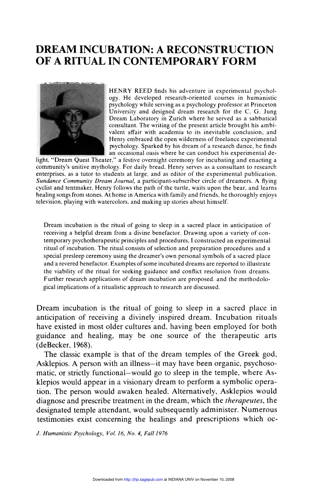As we close our eyes and drift off to sleep, we enter a mysterious and often perplexing world of dreams. These subconscious wanderings can leave us feeling confused, curious, or even frightened. However, with the right tools, we can unlock the secrets of our dreams and tap into their immense power. Utilizing both meditation and dream incubation techniques, we can dive deeper into the hidden meanings of our dreams and gain a better understanding of ourselves. Join us on a journey to explore the intersection of science and spirituality in the realm of dreaming.
The Science Behind Dreams

Have you ever woken up from a dream feeling like it had a deeper meaning? Or perhaps you’ve had a recurring dream that leaves you feeling puzzled. Dreams have been a subject of fascination and wonder for centuries. From a scientific standpoint, although there is still much to be understood, researchers have made significant progress in understanding the mechanisms of dreaming. Let’s take a closer look at the fascinating science behind dreams.
REM Sleep
During REM sleep, the body experiences a paralysis which helps to prevent the individual from acting out their dreams. This state of deep sleep is characterized by rapid eye movement, irregular breathing, and increased brain activity. It is during REM sleep that individuals experience more vivid, realistic, and memorable dreams. Researchers have discovered that these dreams are often associated with memory consolidation, emotional regulation, and problem-solving.
Interestingly, scientists have also found a correlation between the amount of time spent in REM sleep and the level of cognitive function. While lack of sleep or disrupted sleep can negatively impact cognitive performance, sufficient and uninterrupted REM sleep appears to boost it. This makes REM sleep crucial to the overall functioning of the brain and its ability to process and interpret information. It’s important to note that despite the significance of REM sleep, further research is necessary to understand fully its complicated mechanisms and relationship with the rest of the body.
The Importance of Dreams
Our dreams are more than just random images and thoughts that occur when we are sleeping. They can actually provide valuable insight into our subconscious minds and help us better understand our waking lives. While the exact meaning of our dreams may not always be clear, their importance should not be overlooked. Let’s explore some of the reasons why dreams are important:
| 1. Problem-solving | Our dreams can help us find solutions to problems that we may be facing in our waking lives. Because our subconscious mind is allowed to roam free during dream state, it can come up with new and creative ways to approach difficult situations. |
| 2. Emotional processing | Dreams can also help us process and deal with our emotions. Sometimes, we may suppress our feelings during the day but they can manifest in our dreams, allowing us to confront and work through them. |
| 3. Creative inspiration | Many artists and creatives have attributed their successful works to ideas that originated from their dreams. This is because during sleep, our minds are less inhibited, allowing us to explore concepts and ideas that we may not have considered before. |
| 4. Self-discovery | Through dream analysis and interpretation, we can gain a better understanding of our true selves. Dreams can reveal our hidden desires, fears, and motivations, allowing us to better navigate our waking lives. |
| 5. Physical and mental health | The quality of our sleep and our dreams can also have a significant impact on our physical and mental health. Good dreams can contribute to a more restful sleep and improved mood, while nightmares or disrupted sleep can be indicative of underlying mental health issues that should be addressed. |
Dreams are not simply meaningless experiences that occur during sleep. They can provide insight into our subconscious minds, help us find solutions to problems, inspire creativity, and contribute to our overall well-being. Understanding the importance of dreams can help us better appreciate their significance and utilize them for personal growth and development.
What is Dream Incubation?

Have you ever wished you could control what you dream about? Imagine being able to plant a specific idea or question into your subconscious mind and have it manifest as a dream. This is the concept behind Dream Incubation. It’s a technique that goes back centuries, but is still used today as a powerful tool for understanding the symbolism and meaning behind our dreams. If you’re curious about dream incubation and want to learn more about its history and how to practice it, read on.
History of Dream Incubation
Dream incubation is a technique that has been used for longer than written history. Here are some interesting historical facts associated with dream incubation:
- Ancient Egypt: The Egyptian god Serapis was believed to cure people’s ailments and problems through their dreams. Serapis was associated with incubation dreams in which he appeared to the dreamer with a solution to their problem.
- Greek and Roman civilization: The ancient Greeks and Romans believed that dreams were messages from the gods. They built elaborate temples for incubation that were visited by people seeking guidance or healing. These temples were staffed by priests and priestesses who interpreted the dreams of the visitors.
- The Middle Ages: During the Middle Ages, incubation was practiced in Europe by pilgrims who visited the healing shrines of saints. They would sleep in the church and wait for a vision or dream in which the saint would appear and provide guidance.
- Native American culture: Native American cultures have used the technique of dream incubation for thousands of years. They believe that dreams are powerful tools for healing and communication with the spirit world.
Throughout history, dream incubation has been considered a powerful tool for problem-solving, healing, and spiritual growth. The practice has varied across cultures and time periods, but the underlying belief in the power of dreams has remained the same. Today, dream incubation is commonly used as a technique for exploring the subconscious mind and gaining insights into one’s own psyche.
How to Practice Dream Incubation
Dream incubation is a powerful technique for enhancing dream recall and interpreting dreams. To begin practicing dream incubation, follow these simple steps:
- Choose a Question or Intention: Before going to bed, choose a question or intention that you would like to explore in your dreams. This could be a specific problem or issue you are facing, or simply a topic you are curious about.
- Focus Your Mind: Spend some time before bed focusing your mind on your question or intention. You may want to write it down, meditate on it, or simply visualize yourself exploring it in your dreams.
- Set the Stage: Create a comfortable sleeping environment that is conducive to dreaming. Make sure your bedroom is dark, quiet, and free from distractions.
- Relax Your Body: Take some time to relax your body before going to sleep. You may want to take a warm bath, practice some gentle stretching or yoga, or simply lie down and focus on your breath.
- Visualize Your Dream: As you drift off to sleep, visualize yourself exploring your question or intention in your dream. Imagine yourself in a specific location or scenario that relates to your intention.
- Record Your Dream: When you wake up, take a few moments to write down your dream in a dream journal. Include as much detail as possible, even if it seems insignificant or unrelated to your intention.
- Reflect on Your Dream: Spend some time reflecting on your dream and how it relates to your question or intention. Look for patterns or symbols that may provide insight or guidance.
- Repeat: Practice dream incubation regularly to enhance your dream recall and gain deeper insights into your subconscious mind.
By practicing dream incubation, you can tap into the power of your subconscious mind and gain valuable insights into your waking life. With patience and persistence, you can unlock the mysteries of your dreams and uncover hidden truths about yourself and your world.
The Power of Meditation for Dream Interpretation

As we delve deeper into the art of dream interpretation, we cannot overlook the immense power of meditation. The practice of meditation has been proven to positively affect the brain and enhance cognitive processes. It is no wonder that meditation can also enhance our ability to interpret and understand our dreams. Through the power of concentration and self-reflection, we can unlock the mysteries of our subconscious mind and decipher the hidden messages within our dreams. Let us explore the fascinating relationship between meditation and dream interpretation.
How Meditation Affects the Brain
Meditation has been shown to have a positive impact on the brain, with both short-term and long-term benefits. In short-term meditation, the prefrontal cortex, the area responsible for cognitive function and decision-making, becomes more active. Additionally, the amygdala, responsible for the fight-or-flight response, becomes less reactive to perceived threats, resulting in a decrease in stress and anxiety.
In the long term, regular meditation has been found to increase the amount of gray matter in the brain, particularly in areas associated with attention, memory, and emotional regulation. It also enhances the communication between various regions of the brain, leading to improved cognitive function and emotional stability.
During dream meditation, the brain is in a similar state to that during regular meditation, with increased activity in the prefrontal cortex and decreased activity in the amygdala. This can allow for greater awareness and control during a dream, leading to a more vivid and meaningful experience. Additionally, the increased gray matter and improved communication between brain regions resulting from regular meditation can aid in the interpretation and understanding of dream content.
The positive effects of meditation on the brain make it a powerful tool for enhancing dream interpretation and understanding.
Techniques for Dream Meditation
One of the most common techniques for dream meditation is progressive relaxation. This involves lying down in a comfortable position, and then slowly tensing and relaxing each muscle group in the body, starting from the toes and moving up to the head. By doing this, you gradually release any tension in the body and move into a relaxed state that is conducive to dreaming.
Another method is visualization, where you create a mental image of a relaxing scene, such as a beach or a peaceful forest. While visualizing this scene, you focus on your breathing and allow yourself to drift into a state of relaxation.
Some people also find it helpful to use mantras or affirmations during dream meditation. This involves repeating a soothing phrase or word aloud or in your head, such as “I am calm and peaceful” or “I release all stress and tension from my body”.
Finally, breathing exercises can be a useful tool for dream meditation, as they allow you to focus on your breath and quiet the mind. One example is the 4-7-8 technique, where you inhale for four seconds, hold for seven, and exhale for eight.
Remember, not every technique may work for you, and it may take some experimentation to find the right one. The important thing is to find a technique that helps you relax and move into a dream state.
Combining Dream Incubation and Meditation

As we have seen, both dream incubation and meditation can be powerful tools for unlocking the mysteries of dreaming and gaining deeper insights into our subconscious mind. Individually, they offer significant benefits. But what happens when we combine these practices? Can we enhance our ability to interpret our dreams even further? Many experts believe that the answer is a resounding yes. By creatively combining dream incubation and meditation, we can explore the deeper layers of our dream world and gain a better understanding of our thoughts, emotions, and behaviors. Let’s delve into this fascinating topic and discover how we can use these practices in tandem to deepen our connection with our inner selves.
Benefits of Combining Practices
Combining dream incubation and meditation can have powerful benefits for dream interpretation. When utilized together, they can provide a deeper understanding of the unconscious mind and lead to a more insightful interpretation of dreams. Here are some of the benefits of combining these practices:
- Increased Self-Awareness: Dream incubation and meditation can help increase self-awareness as they allow individuals to tap into their unconscious mind and access deeper levels of thought.
- Better Understanding of Symbolism: Dreams often contain symbolism, and combining dream incubation and meditation can help an individual develop a better understanding of those symbols and their meanings.
- Heightened Intuition: By listening to the messages in dreams and following the intuition that arises from dream incubation and meditation, people can make better decisions and achieve their goals.
- Reduced Stress and Anxiety: Both practices can help reduce stress and anxiety by promoting a calm and relaxed state of mind that carries over into daily life.
- Improved Creativity: Dreams and meditation are both creative processes that can unlock new ideas and inspire creativity. Combining them can help individuals tap into their creative potential.
These benefits make dream incubation and meditation valuable tools for individuals seeking to unlock the mysteries of dreaming and lead a more fulfilling life through self-discovery and personal growth.
Recommended Practices
When it comes to combining dream incubation and meditation for dream interpretation, there are several recommended practices that can help enhance the overall experience. These practices not only increase the likelihood of having vivid and insightful dreams, but they also contribute to better recall and analysis of those dreams.
Practice | Description
————-|—————
Consistency | It’s important to be consistent in both your dream incubation and meditation practices. Set aside time each day to practice both techniques, and try to stick to a regular sleep schedule to help promote healthy REM sleep.
Intentions | Before going to bed, set clear intentions for your dreams. Think about specific questions or topics you want to explore in your dreams, and use visualization techniques to help reinforce these intentions.
Relaxation | Prior to meditating or going to bed, take some time to relax and clear your mind. Practice deep breathing exercises, progressive muscle relaxation, or other techniques to help alleviate stress and promote relaxation.
Incubation Rituals | Incorporate specific rituals or objects into your dream incubation practice to help signal to your brain that it’s time to enter a dream state. This could include burning incense, using specific colors, or repeating certain phrases or affirmations.
Meditation Techniques | Experiment with different meditation techniques to help enhance your dream experiences. This could include mindfulness meditation, guided visualization, or yoga nidra.
Dream Journaling | Keep a dream journal and write down your dreams as soon as you wake up. This will help improve dream recall and provide you with more material for interpretation.
Self-Reflection | Take time to reflect on your dreams and think about how they relate to your waking life. Look for symbols, themes, and patterns to help uncover deeper meanings and insights.
By incorporating these recommended practices into your dream incubation and meditation routine, you can unlock the mysteries of your dreams and gain a deeper understanding of your subconscious mind.
Common Dreams and Interpretations
As we explore the mysteries of dreaming, it’s essential to understand that the symbols and scenarios that appear in our dreams are unique to each individual. However, there are some common dreams and interpretations that are shared by many people. Here are a few examples:
| Common Dream | Interpretation |
|---|---|
| Being Chased | This dream often represents anxiety or fear in the waking world. You may be avoiding or procrastinating something that needs to be addressed. |
| Teeth Falling Out | Many interpretations suggest that this dream represents a loss of power or control. You may be feeling self-conscious or insecure about your appearance or ability to communicate effectively. |
| Flying | Dreaming of flying is often associated with a sense of liberation or freedom. You may be experiencing a newfound confidence or sense of adventure in your life. |
| Showing Up Late | This dream typically represents a fear of missing out on opportunities or failing to meet expectations. You may be feeling overwhelmed or pressured in your waking life. |
| Naked in Public | Many interpretations suggest that this dream represents a fear of vulnerability or exposure. You may be feeling self-conscious or exposed in your waking life. |
It’s important to remember that these interpretations are not universal and may vary based on personal experiences and cultural backgrounds. Additionally, dream symbolism can be highly subjective and may require individual exploration and reflection to uncover their meaning. Incorporating techniques such as dream incubation, meditation, and dream journaling can be helpful in gaining deeper insights into the personal symbolism present in our dreams.
Dream Journaling and Reflecting
As we continue to explore the mysteries of our dreams, we uncover the power of dream journaling and reflecting. Dreams offer us a window into our subconscious mind, and by keeping a record of them and reflecting on their meaning, we can gain a better understanding of ourselves and our innermost thoughts. In this section, we will delve into the benefits of dream journaling, the best techniques for keeping a record of your dreams, and how to reflect on your experiences to unlock their meaning. So grab a pen and paper, and let’s explore the realm of dreams together.
Keeping a Dream Journal
Keeping a dream journal is an essential component of unlocking the mysteries of your dreams. Here are some tips on how to start and maintain a dream journal:
- Choose a notebook: Choose a notebook that you will use solely for recording your dreams. Some people prefer a spiral-bound notebook, while others prefer a bound journal.
- Keep it next to your bed: Keep your dream journal next to your bed so that it’s easy to access as soon as you wake up.
- Write in it regularly: Make a habit of writing in your dream journal as soon as you wake up, even if you don’t remember your dream. Write down any thoughts, feelings, or sensations that you experienced upon waking up. Over time, this will help train your brain to remember your dreams better.
- Use descriptive language: Write down every detail that you can remember about your dream. Use descriptive language to capture the vividness of your dreams as much as possible.
- Record the date: Make sure to record the date of each dream entry to help you identify patterns and recurring themes in your dreams.
- Reflect on your entries: Take the time to reflect on your dream journal entries every now and then. Look for common themes, symbols, or emotions that are present in your dreams. This can help provide insight into your subconscious mind.
By keeping a dream journal, you can begin to better understand the language and symbolism of your dreams. This can help you make connections between your dreams and your waking life, ultimately leading to greater self-awareness and personal growth.
Reflecting on Your Dreams
Reflecting on your dreams is an essential part of the dream interpretation process. It allows you to delve deeper into the symbolism and meanings of your dreams. Here are some steps for reflecting on your dreams:
- Recall your dream: Try to recall your dream in as much detail as possible. Write down every aspect of the dream that you can remember.
- Analyze the symbols: Look at the symbols in your dream and try to decipher their meanings. Use a dream dictionary or the internet for help if needed.
- Consider your emotions: How did you feel during the dream? Were you excited, scared, or anxious? Understanding your emotions can provide valuable insight into the dream’s meaning.
- Reflect on your daily life: Consider your current life situation and how it could relate to your dream. Are you facing any challenges or changes in your life?
- Look for patterns: Look for recurring symbols or themes in your dreams. These patterns can provide insight into the deeper meanings of your dreams.
- Consider the people in your dreams: Who was in your dream? What is your relationship with them like in real life? How could they relate to the dream’s meaning?
- Write down your interpretation: After considering all of these factors, write down your interpretation of the dream. This can help you gain a deeper understanding of yourself and your subconscious.
By reflecting on your dreams, you can unlock the mysteries of your subconscious and gain a better understanding of yourself and your life. It may take time and practice, but with patience and perseverance, you can become skilled at dream interpretation.
Identifying Patterns
As you continue to keep a dream journal and reflect on your dreams, it’s common to start noticing patterns and themes. These patterns can provide insight into your personal life and subconscious mind. Identifying these patterns can be done by comparing and analyzing your dreams over time.
One way to identify patterns is by creating a table in your dream journal where you can categorize aspects of your dreams such as setting, people, emotions, and symbols. By doing this, you can quickly and easily identify recurring themes or patterns. For example, if you notice that a certain person appears often in your dreams, you can start to explore the significance of their presence and what it may represent in your waking life.
It’s essential to use strong critical thinking skills when analyzing your dreams and identifying patterns. Avoid jumping to conclusions or making assumptions without exploring all possible meanings. It can be helpful to use online resources or consult with a dream interpretation expert to gain a deeper understanding of the symbols and themes in your dreams.
Remember that everyone’s dreams and interpretations are unique, and what is significant for one person may not hold the same meaning for another. It’s important to trust your intuition and personal insight when analyzing your dreams.
Incorporating dream incubation, meditation, and dream journaling into your daily routine can help unlock the mysteries of your dreams and provide valuable insights into your subconscious mind. By identifying patterns and themes in your dreams, you can gain a better understanding of yourself and your personal life.
Conclusion
In conclusion, utilizing dream incubation and meditation for dream interpretation can be a powerful tool in unlocking the mysteries of your dreams. By intentionally focusing your mind and setting intentions before sleep, dream incubation can bring clarity and insight to your nighttime experiences. The practice of meditation not only benefits the overall health of the brain and body, but it can also enhance dream recall and provide a calm and centered mindset for interpreting dreams.
Combining dream incubation and meditation amplifies the benefits of each practice and can lead to a deeper understanding of your subconscious mind. By reflecting on your dreams and identifying patterns, you can gain valuable insights into your thoughts, emotions, and beliefs.
Keeping a dream journal is a valuable practice for recording your dreams and reflecting on their meaning. Regularly reflecting on your dreams can help you identify recurring themes and patterns, allowing you to gain a deeper understanding of your subconscious mind and how it influences your conscious life.
Incorporating these practices into your daily routine can lead to a greater sense of self-awareness and personal growth. So take some time to explore the depths of your dreams and discover the hidden messages they hold. With consistent practice, you can unlock the full potential of your dream world and use it as a tool for personal transformation.
Frequently Asked Questions
What is the difference between a dream and a nightmare?
A dream is a series of thoughts, emotions, and sensations that occur in the mind during sleep. A nightmare is a frightening or unpleasant dream that can cause feelings of fear, anxiety, and distress.
Can dreams be used for problem-solving?
Yes, dreams can be a valuable tool for problem-solving because they can reveal underlying thoughts and emotions. Dream incubation is a technique that can be used to focus on a specific problem or question before going to sleep, in order to receive guidance through dreams.
Can meditation help with interpreting dreams?
Yes, meditation can help with dream interpretation by improving awareness of the subconscious mind and facilitating a deeper connection with dream images and symbols.
How often should I practice dream incubation?
It is recommended to practice dream incubation consistently, for at least a week or two, in order to establish a regular routine and increase the likelihood of receiving guidance through dreams.
What should I do if I can’t remember my dreams?
If you have trouble remembering your dreams, try setting an intention before going to bed to remember your dreams, keeping a dream journal, avoiding alcohol and drugs before bedtime, and allowing yourself enough time for quality sleep.
How can I use dream journaling to improve my mental health?
Dream journaling can help improve mental health by allowing you to track patterns in your dreams, work through emotions and issues that arise in dreams, and gain insight into your subconscious thoughts and feelings.
Are there any risks associated with practicing dream incubation?
There are no known risks associated with practicing dream incubation, but it is important to approach the practice with a positive and open mindset, and to seek professional help if experiencing significant distress or confusion related to dreams.
Can lucid dreaming be harmful?
Lucid dreaming is generally considered safe, but it is important to approach the practice with caution and to be aware of potential risks such as sleep disruption or overly vivid nightmares.
Can dream symbols have different meanings for different people?
Yes, dream symbols can have different meanings based on personal associations, cultural background, and individual experiences.
Can dreams predict the future?
While some people believe that dreams can predict the future, there is no scientific evidence to support this claim. Dreams are thought to reflect subconscious thoughts and emotions, rather than future events.








